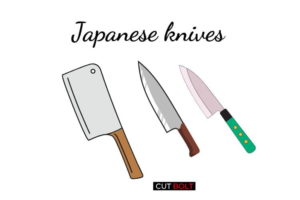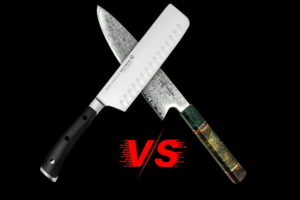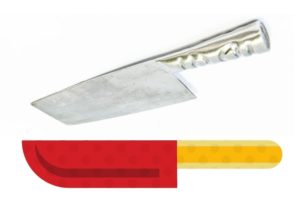Butter knife vs dinner knife: When setting the table for a meal, one might wonder about the different types of knives to use. Two common knives are the dinner knife and butter knife.
While they may look similar, they have different uses and designs. In this article, we will explore the differences between dinner knives and butter knives, their specific functions, and the proper ways to use them.
Introduction to Dinner Knife vs Butter Knife
Knives are essential utensils when it comes to dining. They help in cutting and spreading food, making the dining experience more enjoyable.
While there are various types of knives available, two common types are the dinner knife and butter knife.
Although they may look alike, they serve different purposes.
Understanding the differences between the two knives can help one use them appropriately.
Related: Differences between Chef’s knife and Steak knife
- Introduction to Dinner Knife vs Butter Knife
- What is a Dinner Knife?
- What is a Butter Knife?
- Key Differences between a Butter Knife and a Dinner Knife
- Differences between a Dinner Knife and Butter Knife
- How to Properly Use a Dinner Knife
- How to Properly Use a Butter Knife
- Types of Butter Knives You Need to Know About
- Butter Knife vs Butter Spreader
- Conclusion: Dinner Knife vs Butter Knife
- FAQs: Butter Knife vs Dinner Knife
What is a Dinner Knife?
A dinner knife, also known as a table knife, is a versatile knife used for cutting and slicing food. It is a standard utensil in any formal dining setting. The knife is usually paired with a fork and spoon and is placed on the right side of the plate.
Design and Construction
A dinner knife has a long, pointed blade with a sharp edge, which allows for efficient cutting. The blade is usually around 9-10 inches long, making it ideal for cutting larger pieces of meat. The handle is generally made of wood, plastic, or metal, and is sturdy enough to provide a comfortable grip while cutting.
Uses of a Dinner Knife
The primary function of a dinner knife is to cut and slice food. It is used to cut larger pieces of meat, such as steak or roast. The knife’s sharp edge makes it easy to cut through meat without tearing it apart. It can also be used to slice vegetables or bread. Additionally, the blunt edge of the blade can be used to push food onto a fork or spoon.
Dinner knives are usually placed to the right of the dinner plate, with the blade facing inward.
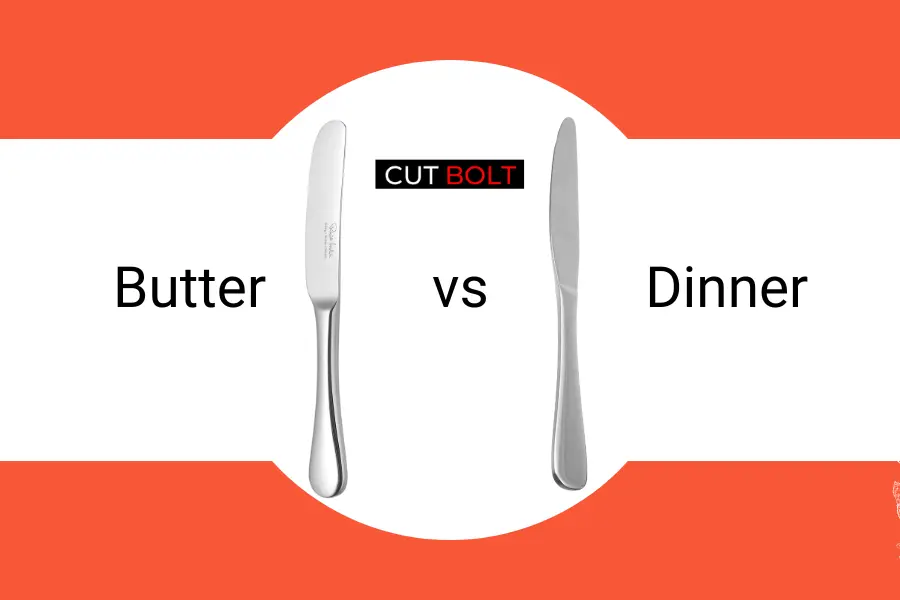
What is a Butter Knife?
A butter knife is a small, flat knife used for spreading butter, jam, and other condiments on bread or toast. It is also referred to as a bread and butter knife or a spreader.
Design and Construction of a Butter Knife
A butter knife has a flat, dull blade that is typically around 5-7 inches long. The blade’s dullness prevents it from tearing the bread or spreading the butter too thickly. The handle is usually made of the same material as the dinner knife, but the handle is shorter and narrower.
Uses of a Butter Knife
The primary function of a butter knife is to spread butter, jam, or other condiments on bread or toast. Its dull blade prevents it from damaging the bread while spreading.
Butter knives are usually placed on the bread plate or butter dish before the meal starts.
Key Differences between a Butter Knife and a Dinner Knife
Now that we know what each knife is used for, let’s take a closer look at the differences between a butter knife and a dinner knife:
- Blade shape: Butter knives have a flat, dull blade, while dinner knives have a pointed blade with a slight serration.
- Blade size: Butter knives are typically smaller than dinner knives.
- Blade edge: Butter knives have a dull edge that is not intended for cutting, while dinner knives have a slightly serrated edge that is designed for cutting.
- Usage: Butter knives are used exclusively for spreading, while dinner knives are used for cutting and eating a wide variety of foods.
Tip:
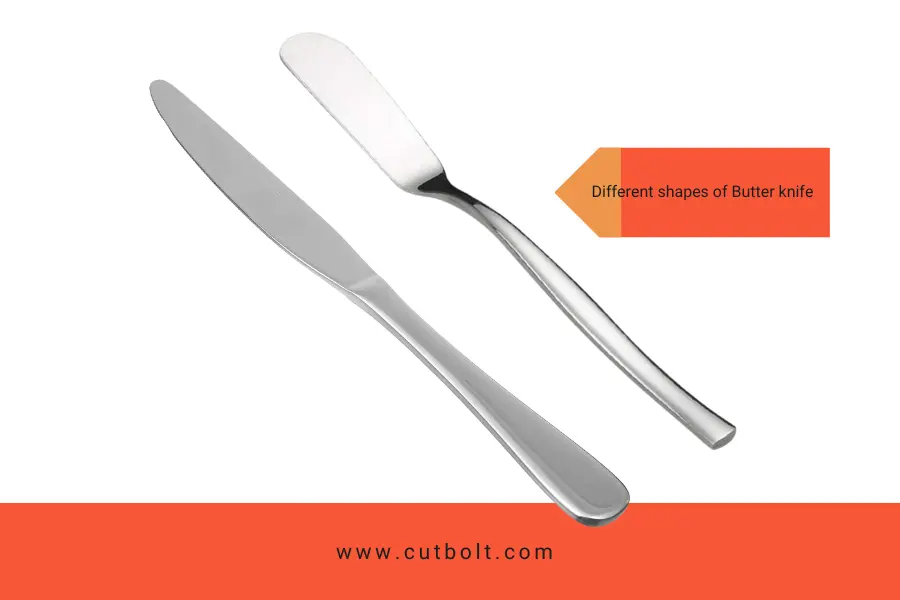
Differences between a Dinner Knife and Butter Knife
Although dinner knives and butter knives may look similar, they have several differences in their design and construction.
| Attributes | Butter Knife | Dinner Knife |
|---|---|---|
| Blade | Thin, dull edge | Thick, sharp edge |
| Purpose | Spreading butter or condiments | Cutting meat and vegetables |
| Blade Length | Shorter | Longer |
| Blade Width | Narrower | Wider |
| Handle | Shorter and narrower | Longer and wider |
| Blade Thickness | Thinner | Thicker |
| Table Setting | Placed on bread plate or butter dish | Placed on the right of the dinner plate |
| Proper Use | Hold with index finger on top and spread with dull edge | Hold with index finger on top and cut with sharp edge |
Small descriptions of the important differences between the butter knife and dinner knife:
Blade Length
A dinner knife has a longer blade than a butter knife. The longer blade is useful in cutting larger pieces of meat or vegetables.
Two common sizes of dinner knives are available, known as the continental-size (also referred to as European size) and the place size (or American size). The continental-size dinner knife is roughly 9-3/4 inches in length, while the place size dinner knife typically measures 9-1/4 inches in length.
Blade Shape
The blade of a dinner knife is pointed and sharp, whereas the blade of a butter knife is flat and dull.
Blade Thickness
Dinner knives have a thicker blade than butter knives.
The thickness of the blade allows for a stronger, more efficient cutting action when slicing through meat and vegetables.
In contrast, butter knives have thinner blades that are not designed for cutting, but rather for spreading condiments.
The thinner blade of a butter knife prevents it from damaging bread when spreading butter or jam.
Handle Design
The handle of a dinner knife is usually longer and wider, providing a sturdy grip for cutting.
The handle of a butter knife is shorter and narrower, allowing for better control while spreading.
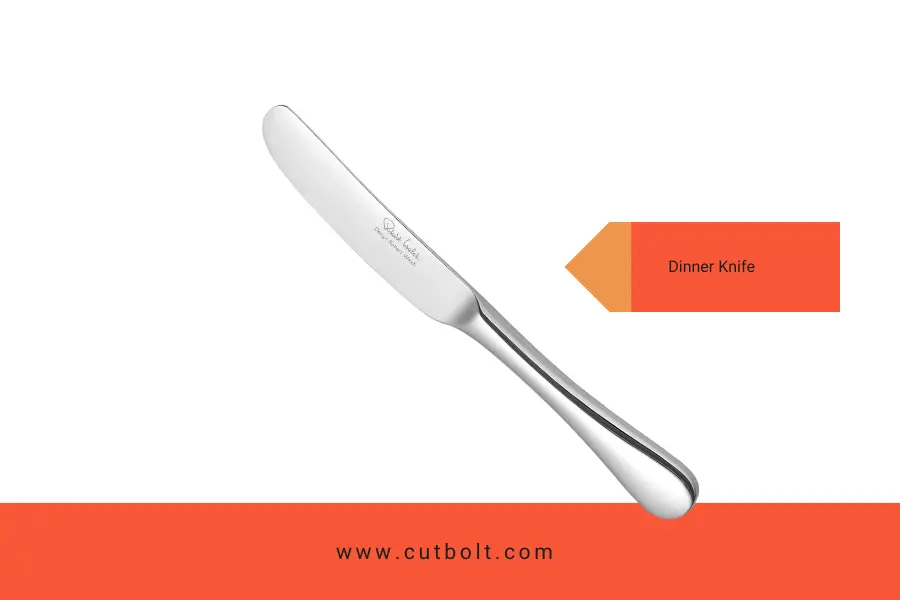
How to Properly Use a Dinner Knife
When using a dinner knife, it is important to hold the knife with the index finger on top of the handle and the thumb and other fingers wrapped around the handle’s bottom. Cut small pieces of meat or vegetables with the sharp edge of the blade, and then push the food onto the fork or spoon with the blunt edge.
The Many Uses of a Dinner Knife: A Culinary Necessity
When it comes to dining, few utensils are as essential as the dinner knife. It is a versatile tool that helps us enjoy our meals and allows us to savor every bite with ease. In this article, we will delve deeper into the many uses of a dinner knife and why it is an indispensable item in every kitchen and restaurant.
Slicing Through Cooked Foods with Ease
The dinner knife is designed to slice through cooked foods with its slightly serrated edge. From fish to leaner cuts of meat, it can tackle a variety of dishes.
Its sharpness also makes it the perfect tool for cutting vegetables and fruits, making it an all-around multipurpose knife.
However, thicker cuts of meat and roasts may require a sharper and more robust blade.
A Tool for Every Occasion
In formal settings, you may come across specialized knives that are suited for specific courses or foods. For instance, salad or fish knives are designed to make dining more enjoyable for guests.
However, in most homes and restaurants, the dinner knife is more than adequate to handle all types of food. Its versatility and functionality make it a go-to choice for any dining situation.
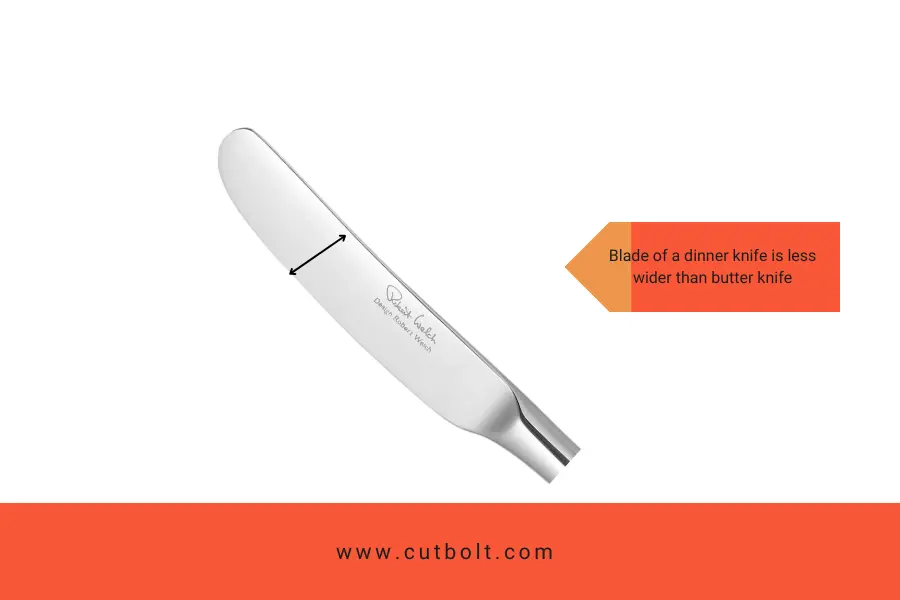
How to Properly Use a Butter Knife
When using a butter knife, hold the knife with the index finger on top of the handle and the thumb and other fingers wrapped around the bottom. Use the dull edge of the blade to spread butter, jam, or other condiments on bread or toast. The knife’s flat shape prevents it from damaging the bread while spreading.
The Many Uses of a Butter Knife
Butter knives are one of the most versatile tools in the kitchen. While they are primarily used for spreading butter, there are many other ways to use this utensil.
Spread Away
As we mentioned before, the primary use of a butter knife is to spread butter. This can include adding a pat of butter to a baked potato, spreading butter on toast, or even using it to spread condiments like jam or mustard.
Creative Plating
While formal dining typically limits the use of butter knives to butter only, at home, you can get creative with how you use this utensil. For example, you can use a butter knife to create beautiful patterns with sauces on your plate, or to spread toppings on a pizza. Butter knives are also great for placing on charcuterie boards due to their small size.
Butter Knife is Not for Cutting
One thing to keep in mind when using a butter knife is that it is not meant for cutting. Unlike other kitchen knives, butter knives have a dull edge, which means they are not suitable for cutting through vegetables, meat, or fish.
Now that you know about butter knife quite well, it is time to know that we have different types of butter knives.
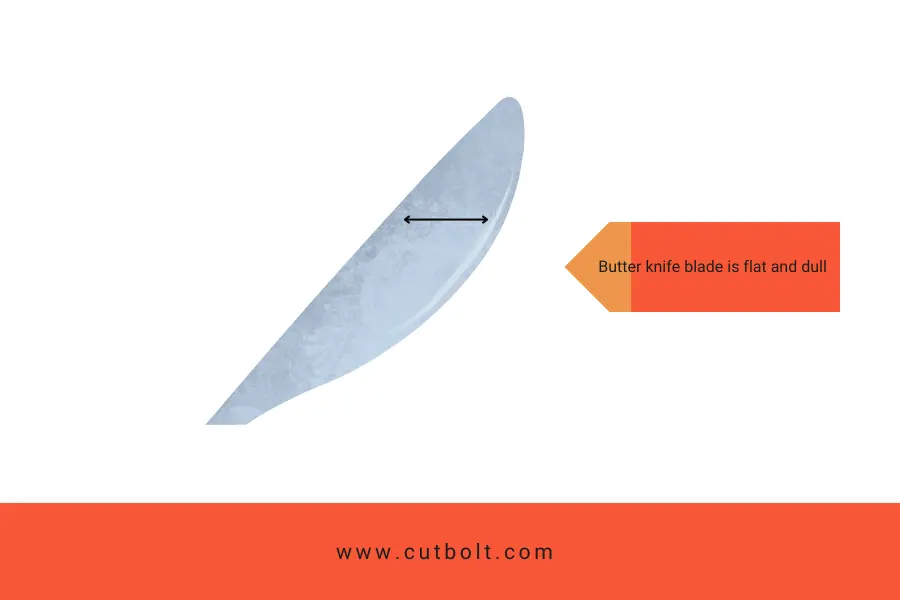
Types of Butter Knives You Need to Know About
When it comes to setting the perfect table, choosing the right cutlery is essential. This includes selecting the right type of butter knife. But did you know that there are different types of butter knives? In this article, we will explore the two most common types of butter knives and their uses.
Master Butter Knife
The Master Butter Knife is a versatile utensil that is commonly found in formal dining settings. It looks similar to a paring knife with a sharp tip, but it has a dull blade. This design makes it perfect for cutting a pat of butter from the main butter dish and transferring it onto the individual’s plate.
Once the butter has been transferred, the Master Butter Knife can also be used to spread butter on bread or other foods. The knife’s sharp tip can be used to pierce through the butter, making it easier to spread. The Master Butter Knife is an elegant and practical utensil that adds a touch of sophistication to any table setting.
Butter Spreader
A Butter Spreader is a knife that is specifically designed for spreading butter on bread. It has a dull blade and a rounded tip, making it ideal for spreading butter smoothly and evenly. Unlike the Master Butter Knife, the Butter Spreader is kept on the bread plate for individual use.
Butter Spreaders come in different styles and designs, making it easy to find one that suits your personal preference. Some are flat with flat handles, while others have hollow handles. Some may even have a slightly bent blade for easier spreading.
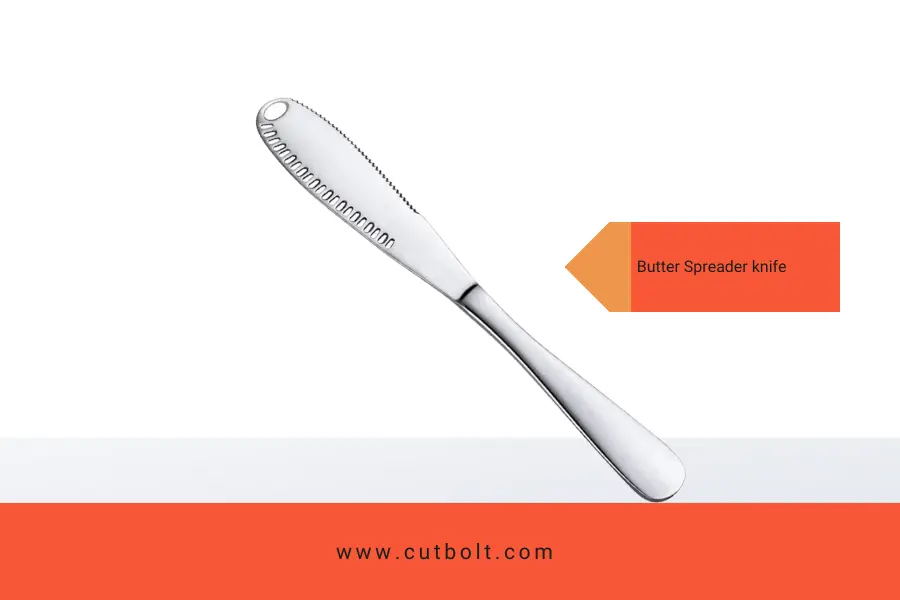
Butter Knife vs Butter Spreader
Butter Knife: A butter knife typically has a pointed end that can cut through butter. Its main function is to transfer butter from a communal butter dish to an individual’s plate. This type of knife is usually reserved for formal dining settings and is primarily used for spreading butter on bread or rolls.
Butter Spreader: A butter spreader, on the other hand, has a rounded end that is specifically designed not to puncture bread. Its primary purpose is to spread butter on bread or toast once it has been placed on the individual’s bread plate. Butter spreaders are typically used in more casual settings, such as at home or at informal gatherings.
Conclusion: Dinner Knife vs Butter Knife
When deciding between a butter knife and a dinner knife, it ultimately depends on what you are eating and the occasion. For most everyday meals at home, a dinner knife is sufficient for cutting and spreading butter.
However, if you are looking to create a more formal dining experience, adding a butter knife to your place setting can add a touch of elegance. Additionally, butter knives can be helpful in snacking or spreading small amounts of food.
Ultimately, both types of knives can be at your dinner table, depending on your preferences and the situation.
We hope this information has been helpful in understanding the differences between these two knives and their intended uses.
FAQs: Butter Knife vs Dinner Knife
-
Can a butter knife stab you?
No, a butter knife is not designed to be sharp enough to be able to cause stabbing injuries. While it is possible to injure yourself with a butter knife, it would require a great deal of force and is unlikely to cause any serious injury.
-
Can I use a butter knife to apply wax?
No, you should never use a butter knife to apply wax. The material of the butter knife is too soft and is not strong enough to hold the wax in place. A wax applicator or a putty knife is a better choice for applying wax.
-
Can you sharpen a butter knife?
No, you should not sharpen a butter knife. Butter knives are designed to be dull so that they can spread butter more easily. Attempting to sharpen a butter knife could damage the blade and make it unsafe to use.
-
Can you stab someone with a butter knife?
No, you cannot stab someone with a butter knife. Butter knives are not designed to be used as a weapon and have a rounded, dull blade that is not sharp enough to inflict serious injury. Additionally, a butter knife is not strong enough to penetrate the skin, so even if you tried to stab someone, it would not cause any harm.
-
How long is a butter knife in inches?
A butter knife is typically around 5 to 7 inches in length.
-
Is a steak knife sharper than a butter knife?
Yes, a steak knife is generally sharper than a butter knife. Steak knives are designed with sharper edges and a more pointed tip to make it easier to cut through steak and other tough meats. Butter knives, on the other hand, are designed to be more blunt and have a rounded tip, making them better suited for spreading butter or other soft foods.
-
Can you carve a pumpkin with a butter knife?
No, you cannot carve a pumpkin with a butter knife. Carving a pumpkin requires a sharp tool such as a serrated knife, a craft knife, or a pumpkin carving tool. A butter knife is too dull and would not be able to cut through the tough skin of a pumpkin.
-
What does it mean when you drop a butter knife?
When you drop a butter knife, it typically means that you have accidentally knocked it off of a surface or table. Generally, it is not a sign of any greater meaning, but simply an accidental mishap.
-
Are butter knifes considered lethal weapons?
No, butter knives are not considered lethal weapons. Butter knives are not sharp enough to inflict any serious harm and are generally used to spread butter or other spreads on food. They are not designed to be used as a weapon, and therefore do not fall into the category of lethal weapons.
-
Can a butter knife be too sharp?
No, a butter knife cannot be too sharp. A butter knife is typically not sharpened very much in order to prevent accidental cuts, so it is unlikely that it would be too sharp.
-
Can a butter knife cut skin?
No, a butter knife is not sharp enough to cut skin. It may be able to scratch the skin if used with enough force, but it is not suitable for cutting.
-
Can a butter knife kill you?
No, a butter knife cannot kill you. However, if used in certain dangerous ways, it may cause injury or harm.
-
Can I bring a metal butter knife on a plane?
No, you cannot bring a metal butter knife on a plane. All items that could be used as a weapon, such as knives, are prohibited in carry-on baggage. Even butter knives are considered to be a security risk and are not allowed on planes. You should leave any metal butter knives at home or in your checked luggage.
-
Can I use a butter knife to cut meat?
No, a butter knife is not designed for cutting meat. It has a dull blade and may damage the meat.
-
Can I use a dinner knife to spread butter?
Yes, a dinner knife can be used to spread butter, but it may be more challenging to control the amount of butter being spread.
-
Should I place both a dinner knife and a butter knife on the table setting?
Yes, both a dinner knife and a butter knife should be included in a formal table setting.
-
Is it appropriate to use my hands to break bread instead of using a knife?
Yes, it is acceptable to break bread with your hands. However, if bread is served sliced, it is best to use a knife.
-
What is the proper placement of a butter knife on a table setting?
A butter knife should be placed on the bread plate or on the butter dish, if one is provided.
Related: Nakiri knife vs Santoku knife

